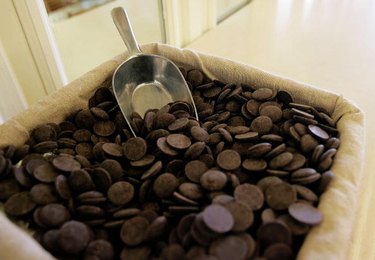
The origin of chocolate is derived from the cacao bean (pronounced "kuh-KOW"), which quite simply are the seeds of the cacao fruit. According to "Chocolate: History, Culture and Heritage," the use of cacao by humans is well beyond 5,000 years old and was eaten by the Native Americans, Aztecs, Olmecs and Mayans. Once symbolic of great wealth, the Mayans were the first civilization to use cacao beans as a source of currency; however, it was the Europeans who first combined cacao with refined sugars.
Raw vs. Roasted
Video of the Day
The cacao bean is the food that all of the scientific studies on chocolate are actually referring to, not its sugary refined byproduct. Although major leading chocolate companies make strong mention of their products' high antioxidant content, the cacao bean has an exceptionally significantly greater antioxidant capacity. The manufacturing of chocolate generally consists of heating the cacao beans at approximately 250 degrees, a process that destroys the world's most powerful food known for centuries as "the food of the God's."
Video of the Day
Roasted Cacao
What you probably never learned from reading the wrapper of a candy bar is that the refined sugar found in chocolate depletes the body of minerals, can cause blood sugar disorders and can result in dehydration of the body. The cacao bean has a higher vitamin C content than any other food in the world; however, chocolate contains no vitamin C at all because it is all destroyed when it is heated.
Raw Cacao
David Wolfe, one of the world's leading authorities on nutrition, discusses in his book "Naked Chocolate" the greater good of eating chocolate in its raw, natural state as the cacao bean rather than as a processed sweet treat. He explains how key nutrients are destroyed and sapped of their health properties when the original cacao bean is excessively heated, roasted, toasted or melted. Wolfe educates his readers of the seemingly endless health benefits possessed by the cacao bean, most of which do not stand a chance of survival once it is heated and converted to chocolate.
Mineral Content
Very few foods in the world can be used as an actual mineral supplement but cacao is one of them. Cacao contains the highest natural source of magnesium, chromium, iron, zinc, copper and manganese, all of which are the most deficient minerals in the world.
Mood
Cacao has a long-standing reputation as being referred to as both a "love chemical" and a "bliss chemical." Cacao contains properties with therapeutic levels that positively affect a person's mood, memory, appetite, pain perception, feelings of attraction, excitement and euphoria. It also contains high concentrations of arginine, an amino acid that increases sexual desire by increasing blood flow throughout the body.
Antioxidants
Cacao contains the alkaloid theobromine, which dilates the body's capillaries. This process allows other foods that are eaten with cacao to be absorbed deeper into your system more so than through any other process. Cacao is the most complex food in the world. With more than 1,200 constituents, it contains a far greater amount of antioxidants than all of the world's leading antioxidant-rich foods. Cacao is so powerful that it actually contains 15 times more antioxidants than blueberries, 20 times more than green tea and 30 times more than red wine.